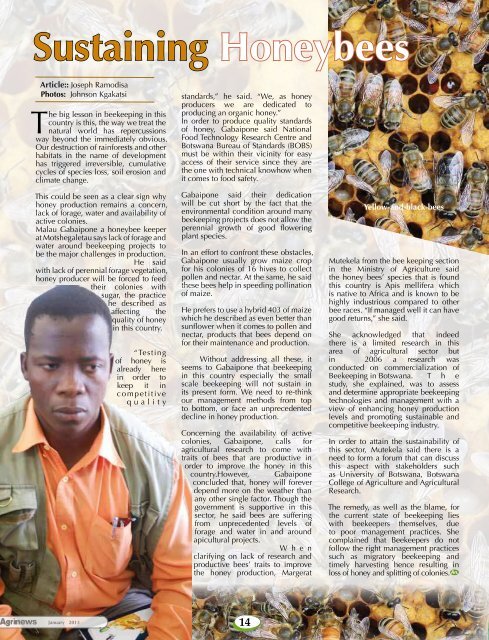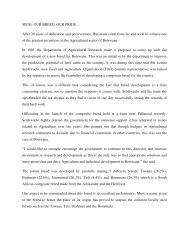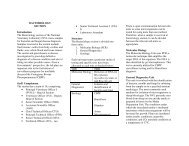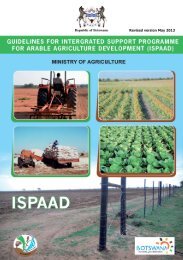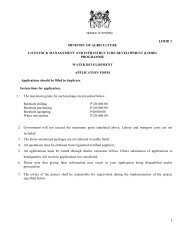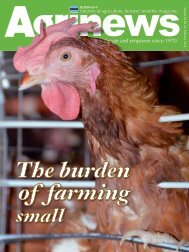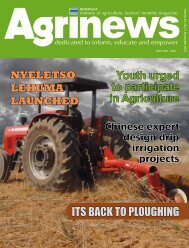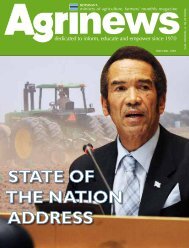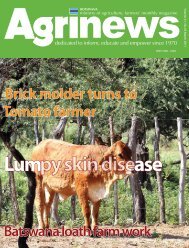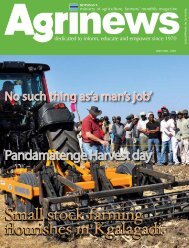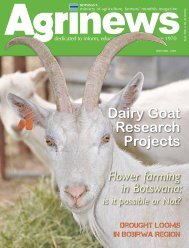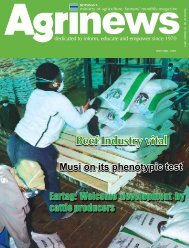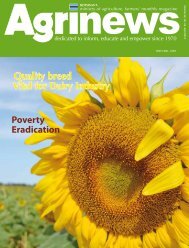Agrinews January 2013 - Ministry of Agriculture
Agrinews January 2013 - Ministry of Agriculture
Agrinews January 2013 - Ministry of Agriculture
You also want an ePaper? Increase the reach of your titles
YUMPU automatically turns print PDFs into web optimized ePapers that Google loves.
Sustaining Honeybees<br />
Article:: Joseph Ramodisa<br />
Photos: Johnson Kgakatsi<br />
The big lesson in beekeeping in this<br />
country is this, the way we treat the<br />
natural world has repercussions<br />
way beyond the immediately obvious.<br />
Our destruction <strong>of</strong> rainforests and other<br />
habitats in the name <strong>of</strong> development<br />
has triggered irreversible, cumulative<br />
cycles <strong>of</strong> species loss, soil erosion and<br />
climate change.<br />
This could be seen as a clear sign why<br />
honey production remains a concern,<br />
lack <strong>of</strong> forage, water and availability <strong>of</strong><br />
active colonies.<br />
Malau Gabaipone a honeybee keeper<br />
at Motshegaletau says lack <strong>of</strong> forage and<br />
water around beekeeping projects to<br />
be the major challenges in production.<br />
He said<br />
with lack <strong>of</strong> perennial forage vegetation,<br />
honey producer will be forced to feed<br />
their colonies with<br />
sugar, the practice<br />
he described as<br />
affecting the<br />
quality <strong>of</strong> honey<br />
in this country.<br />
“Testing<br />
<strong>of</strong> honey is<br />
already here<br />
in order to<br />
keep it in<br />
competitive<br />
q u a l i t y<br />
standards,” he said. “We, as honey<br />
producers we are dedicated to<br />
producing an organic honey.”<br />
In order to produce quality standards<br />
<strong>of</strong> honey, Gabaipone said National<br />
Food Technology Research Centre and<br />
Botswana Bureau <strong>of</strong> Standards (BOBS)<br />
must be within their vicinity for easy<br />
access <strong>of</strong> their service since they are<br />
the one with technical knowhow when<br />
it comes to food safety.<br />
Gabaipone said their dedication<br />
will be cut short by the fact that the<br />
environmental condition around many<br />
beekeeping projects does not allow the<br />
perennial growth <strong>of</strong> good flowering<br />
plant species.<br />
In an effort to confront these obstacles,<br />
Gabaipone usually grow maize crop<br />
for his colonies <strong>of</strong> 16 hives to collect<br />
pollen and nectar. At the same, he said<br />
these bees help in speeding pollination<br />
<strong>of</strong> maize.<br />
He prefers to use a hybrid 403 <strong>of</strong> maize<br />
which he described as even better than<br />
sunflower when it comes to pollen and<br />
nectar, products that bees depend on<br />
for their maintenance and production.<br />
Without addressing all these, it<br />
seems to Gabaipone that beekeeping<br />
in this country especially the small<br />
scale beekeeping will not sustain in<br />
its present form. We need to re-think<br />
our management methods from top<br />
to bottom, or face an unprecedented<br />
decline in honey production.<br />
Concerning the availability <strong>of</strong> active<br />
colonies, Gabaipone, calls for<br />
agricultural research to come with<br />
traits <strong>of</strong> bees that are productive in<br />
order to improve the honey in this<br />
country. However, Gabaipone<br />
concluded that, honey will forever<br />
depend more on the weather than<br />
any other single factor. Though the<br />
government is supportive in this<br />
sector, he said bees are suffering<br />
from unprecedented levels <strong>of</strong><br />
forage and water in and around<br />
apicultural projects.<br />
W h e n<br />
clarifying on lack <strong>of</strong> research and<br />
productive bees’ traits to improve<br />
the honey production, Margerat<br />
Yellow-and-black-bees<br />
Mutekela from the bee keeping section<br />
in the <strong>Ministry</strong> <strong>of</strong> <strong>Agriculture</strong> said<br />
the honey bees’ species that is found<br />
this country is Apis mellifera which<br />
is native to Africa and is known to be<br />
highly industrious compared to other<br />
bee races. “If managed well it can have<br />
good returns,” she said.<br />
She acknowledged that indeed<br />
there is a limited research in this<br />
area <strong>of</strong> agricultural sector but<br />
in 2006 a research was<br />
conducted on commercialization <strong>of</strong><br />
Beekeeping in Botswana. T h e<br />
study, she explained, was to assess<br />
and determine appropriate beekeeping<br />
technologies and management with a<br />
view <strong>of</strong> enhancing honey production<br />
levels and promoting sustainable and<br />
competitive beekeeping industry.<br />
In order to attain the sustainability <strong>of</strong><br />
this sector, Mutekela said there is a<br />
need to form a forum that can discuss<br />
this aspect with stakeholders such<br />
as University <strong>of</strong> Botswana, Botswana<br />
College <strong>of</strong> <strong>Agriculture</strong> and Agricultural<br />
Research.<br />
The remedy, as well as the blame, for<br />
the current state <strong>of</strong> beekeeping lies<br />
with beekeepers themselves, due<br />
to poor management practices. She<br />
complained that Beekeepers do not<br />
follow the right management practices<br />
such as migratory beekeeping and<br />
timely harvesting hence resulting in<br />
loss <strong>of</strong> honey and splitting <strong>of</strong> colonies.<br />
FODDER PRODUCTION<br />
Legumes provide both pods and leaves consumed by animal as<br />
fodder due to their characteristics the domesticated are, Siratro,<br />
Leucaena locapala, Stylosanthes guianensis, Dolichos lablab.<br />
also a major component <strong>of</strong> production<br />
inputs to run machineries with costs.<br />
Fodder production it is task <strong>of</strong><br />
producing crops that are specifically<br />
planted to produce feed for livestock.<br />
The crops are usually not grazed or<br />
browsed at the field they are harvested<br />
and processed to during dry season.<br />
The crops respond positively to the<br />
standard recommend management<br />
practices such as good seedbed<br />
preparation, planted in time when<br />
soil moisture is adequate and proper<br />
weeding. Increased quantity (biomass)<br />
and quality when timely harvested<br />
whole the plant including utilization<br />
<strong>of</strong> residues such husks if properly dried<br />
and stored in well ventilated structures<br />
( fodder bans).<br />
There are major two components <strong>of</strong><br />
fodder rations<br />
ENERGY CROPS PROVIDERS<br />
Most <strong>of</strong> crops belong to family<br />
gramineae like maize, millet, sugar<br />
cane; sorghum can be used, by being<br />
harvested during flowering stage and<br />
slowly dried and stored while still<br />
maintaining greenish color. Top leaves<br />
<strong>of</strong> groundnuts, jugo beans can also be<br />
processed the same way and be added<br />
as one package. The other methods to<br />
preserve the above crops are by cutting<br />
them when still fresh and make silage<br />
out them.<br />
Grasses species such as Cenchrus<br />
ciliaris, Digitria eratnha Napier,aClhoris<br />
guyana and many others can be planted<br />
and grazed as standing hay (in the field),<br />
or dried baled as Hay. Other exotic<br />
species such as Silk, Sudan halipense<br />
sorghums are common in the country<br />
and can be propagated as fodder, not<br />
excluding many others. Amongst the<br />
above stated exotic species Napier is<br />
preferred to do silage or cut and curry<br />
because <strong>of</strong> it gives higher yield per ha<br />
(can be harvested in every 6months<br />
and give up to 7tones per ha).<br />
Other plants which provide production<br />
feeds are sunflower, groundnuts,<br />
Jatropha, Neem; Moringa fed as<br />
cakes after oil has been extracted<br />
and plants such as especially for oil<br />
filtered for various purposes, eatable,<br />
cosmetics, the most that can benefit<br />
livestock industry is when the same oil<br />
combined with alcohol like menthol or<br />
ethanol to produce bio-fuel to run farm<br />
machineries.<br />
We all understand that factor for<br />
production is vital in achieving great<br />
goals in agriculture. They include<br />
Land, machineries/equipment, and<br />
manpower and technology transfer. The<br />
continuous land utility in production<br />
need replenished nutrients by chemical<br />
fertilizers which are much costly; fuel is<br />
Therefore reduction <strong>of</strong> costs is one<br />
fundamental phenomenon safest to<br />
agricultural investment that increases<br />
food to our increasing population. The<br />
costs <strong>of</strong> variable inputs <strong>of</strong> production<br />
such as fertilizers, fuel, and pesticides<br />
become a barrier towards wide<br />
production to be self sufficient in<br />
agricultural products which are the<br />
most basic needs <strong>of</strong> human existence.<br />
It is important to nature care the<br />
land, pest using natural resources and<br />
organic materials in the sense <strong>of</strong> costs<br />
reduction. I have in previous shared<br />
with all <strong>of</strong> you about some tree species<br />
such Moringa and Jatropha currently<br />
I have discovered NEEM which could<br />
boast agriculture in many ways which<br />
survive very well in our climatic<br />
condition<br />
These trees need to be incorporated<br />
in our agricultural practices to aid in<br />
organic operation such fertilizers, pest<br />
control and reductions <strong>of</strong> costs by<br />
utilizing other natural resources wisely<br />
and pr<strong>of</strong>itably.<br />
PRODUCTION FEED CROPS<br />
Legumes are crops that have significant<br />
contribution in fodder production,* as<br />
a major <strong>of</strong> source protein provider;<br />
with vital contribution to agric-socio<br />
economic values.<br />
(1) Amongst those that are domestically<br />
planted, build soils structure through<br />
their tap roots that penetrate soils<br />
breaking the soil particles further to<br />
reset soil aggregates. They utilize<br />
14 15<br />
deeper nutrients and water which other<br />
plants are unable reach, to breakeven<br />
competition among plants in the same<br />
areas.<br />
(2) Have the ability to fix atmospheric<br />
N2 through the Rhyzobia species<br />
that ultimately become available to<br />
other plants which give other crops<br />
advantage to grow vigorously at same<br />
time cut costs <strong>of</strong> artificial nitrogen<br />
fertilizer to the soils.<br />
(3) Other legumes enhance high forage<br />
and have broad leaves that mulch the<br />
soils resulting in reduction <strong>of</strong> water<br />
evaporation hence conserve soil<br />
moisture for plants sustainability. The<br />
above characteristics symbolized the<br />
crops to be highly nutritious feed and<br />
be regarded as production feed.<br />
Legumes provide both pods and leaves<br />
consumed animal as fodder due to<br />
their characteristics the domesticated<br />
are, Siratro, Leucaena locapala,<br />
Stylosanthes guianensis, Dolichos<br />
lablab. Dolichos lablab is among<br />
others the best and common legume<br />
produced in the country and fed to<br />
cattle, goats, ostrich, poultry, goats,<br />
donkeys and sheep. It has shown the<br />
best results recognized and enjoyed by<br />
the farmers one advantage with lablab<br />
yields more than other legumes, it is<br />
SPECIES USES agriculture COMMENTS<br />
Moringa tree Seeds produces Oil combined with menthol or<br />
-Eatable and Bio fuel<br />
ethanol produce Bio fuel (diesel)<br />
-Cake after extraction <strong>of</strong> The trees present at Mahalapye,<br />
oil is good for fodder Letlhakane, and Maun<br />
-Leaves wet & dried leaves<br />
increase weight gain and milk<br />
-Water purifier<br />
-Fertilizer ( Plant enhancer)<br />
-Pest control<br />
Jatropha Seeds produces Mentholated produces diesel<br />
-Oil for lubricant<br />
to run machineries<br />
Cake after extraction <strong>of</strong> oil is Are present in Tonota<br />
good for fodder<br />
Neem Seeds produces Add menthol or Ethanol end<br />
(Azadirachta indica) -Oil Bio fuel product diesel<br />
-Cake after extraction <strong>of</strong> oil seen in Serowe<br />
is good for fodder<br />
-Fertilizer ( Plant enhancer)<br />
-Pest control<br />
SUNFLOWER - Seeds Produces eatable oil. The plants are planted arable<br />
-Husks used as fodder around the country.<br />
- Cake after extraction <strong>of</strong><br />
oil is good for fodder<br />
palatable that herding <strong>of</strong> these animals<br />
become a relief to farmers because they<br />
do range and come back to homestead<br />
to look for lablab.<br />
They are wild legumes such as<br />
Dichrostachys ceneria (moselesele),<br />
Acacia tortilis (Mosu), Acacia<br />
erubescenes (Moloto) which can be<br />
collected and nicely stored to be used<br />
as Fodder especially to small stock.<br />
Fodder production in Botswana is<br />
recognized insignificantly despite the<br />
adverse conditions that act negatively<br />
towards productivity <strong>of</strong> livestock<br />
and Small stock which 80% farming<br />
communities are basically depend on<br />
continued on next page<br />
<strong>January</strong> <strong>2013</strong> <strong>January</strong> <strong>2013</strong>


